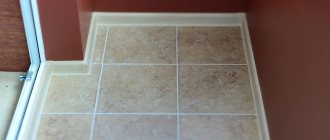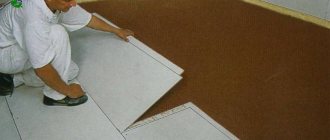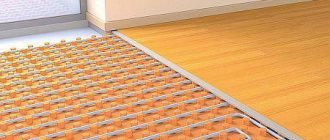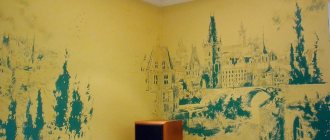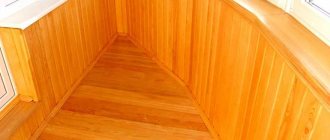Water decorative elements refresh the exterior, regardless of the area of the site. Even in the most modest courtyard there is room for an artificial pond or fountain, decorated with natural stone and aquatic plants. No less popular are dry streams, which from afar skillfully imitate moving water or hint at its presence. The article talks about how to make a dry stream at your dacha with your own hands, the intricacies of its design, the rules for carrying out the work and the choice of material.
The concept of "dry stream"
A dry stream or decorative channel is a type of landscape design element, identical in principle to a Japanese rock garden. Its simplicity of construction and minimum maintenance make it a popular item for decorating a garden plot. It looks like a kind of river bed, in which natural stones are used instead of water.
A dry stream can transform any problematic terrain of a site Source www.propertymasterslandscaping.com
Alpine slide combined with a dry stream Source pinimg.com
There is no official classification of dry streams. The breakdown occurs according to unspoken signs displayed in appearance. The exact breakdown of the decorative channel is determined for each site individually. Among the most popular options, the following should be noted:
- Winding stream. A body of water in one channel, prone to expansion or contraction along its entire length.
- Branched stream. Consists of several channels. The appearance is constructed in different ways, depending on the plans of the organizers. They can converge and diverge into 2 or more streams, spilling into small reservoirs.
- Waterfall, cascade. It is used in areas with significant relief differences. One of the arrangement options may look like this: on an artificially created platform made of stones, an old jug lies on its side. Small stones imitating a river flow fall down to the ground. Here they turn into a mountain river with rapids, which are created using flat stones.
Construction principle
When arranging an artificial water stream, one principle is used: a pump pumps water from a reservoir located at the lowest point on the site to the highest point of the stream. After this, the water from the highest point flows down a natural slope.
In order for the construction of a water stream to be successful, it is important to plan it correctly: choose a location and make a slope that ensures the natural movement of water.
If you plan to make a stream that would resemble a natural spring, then use the existing terrain. A water stream can go around garden sculptures and flower beds, flow near trees in the garden or recreation areas, creating small waterfalls, quiet pools, islands, or shallows. By respecting natural forms, you can achieve the naturalness of a stream.
Natural outlines of an artificial stream
Replacing natural outlines with geometry looks unnatural. Such a stream will look more like a ditch.
Before you make a stream, think through all the details. For example, does the terrain allow for the creation of a waterfall? Is there a need for a second pond? Will it be a small stream or will it go around a decent part of the site? The longer the stream, the more equipment you will need to arrange it.
The coast can be decorated with flowering plants. The list of plants that love moist soil includes: hostas, sedge, bergenia, meadowsweet, and bathwort. As for the length and width of the channel, it all depends on you. Standard sizes vary between: width – 0.5–1.5 m, and depth – 0.3–0.5 m.
Materials
To organize a dry stream in the country, you will need a minimum of materials and time. Mainly for its arrangement, river pebbles ground by water are used. If it is not possible to obtain the amount of stone for the entire project, sand is used. With its help, an imitation of a dry river bed is created using a similar principle, and an additional visual effect is given by the creation of wavy ridges rising above the surface.
Healthy! Natural stone for creating a dry stream can be purchased at garden stores.
Step-by-step creation of a decorative element
To create a beautiful dry stream with your own hands, you will need the following set of tools and materials:
- Sand, especially if there are not enough stones.
- River or sea pebbles. Today you can buy ready-made stone, cut for the construction of a dry stream.
- Pegs and cord for marking the territory.
- A shovel is useful for removing the surface layer of soil.
To prevent the growth of weeds, it is necessary to lay geotextiles, so care should be taken to ensure its availability at the preparatory stage.
How to properly make a dry stream in the country step by step
Organizing your own dry stream occurs in 4 stages: developing a project, preparing the base (bed), laying stones, and installing additional decorative elements.
Project development, planning
Before making a dry stream, a project is developed with a mandatory “reference” to the real landscape. All possible execution options are written down on paper. In this case, you will not forget anything, and from all the variety of ideas you will be able to choose the one you like best.
If you do not have drawing skills, you can make ordinary sketches. The main thing is that they are understandable to the performer, repeat the landscape of the site as accurately as possible, and specify the distances to several landmarks (the more, the better). For example, to a flower bed, gazebo, path or something else.
Raw stone against the background of a dry stream Source minskland.by
Stone garden with a flowing dry stream Source veselyi-yrozhainik.ru
Having decided on the final layout of the dry stream bed, you can begin marking the area. To do this you will need wooden or metal pegs and laces. When marking straight sections, the distance between beacons can be up to 500 mm. Marking of spills and bends is carried out with a minimum distance from each other (100-200 mm).
Dry stream flowing from a jug Source studio25.com
Multi-colored pebbles using the example of a dry stream Source 2proraba.com
Advice! It will not be possible to build a full bend using pegs and string. If you want to see the preliminary outlines of a future project, “draw” it with sand.
If you are satisfied with the result you see, we move on to the next stage. Otherwise, we make adjustments and evaluate again.
See also: Catalog of companies that specialize in landscaping work on sites.
Preparing the base
There is no need for a deep channel; removal is 150 mm. There is enough fertile layer. After leveling the resulting trench with a shovel and rake, remove large roots. The next step will be laying geotextiles that allow moisture and air to pass through, but prevent the germination of weeds. Some of the seeds will fall from above (by the wind), but the number of sprouted shoots is not so large and is removed in a minimum period of time.
“Revived” dry stream Source roomester.ru
Important! If the construction of a dry stream is carried out on rocky soil, the geotextile may tear on the sharp edges of protruding stones. In this case, a sand cushion is poured out and only the material is laid on it.
Laying stones
The next steps depend on the size and shape of the stones being placed. If there is a possibility of damage to the geotextile, the sand cushion is poured again. Similar actions are performed when using a large cobblestone. Sand is necessary to completely cover the material.
Making a dry stream in your dacha yourself Source sveklon.ru
Important! Any stone of natural origin is used as filling: crushed stone, sandstone, rubble, river pebbles. The size and shape are selected depending on the characteristics of each individual project. The use of construction waste (shards of concrete, broken bricks) is strictly prohibited.
Placement of stone in the bed of a dry stream is carried out according to the project, but it is best to lay it according to the classical principle. Large - along the riverbed, imitating the coastline; fine and medium are used to create flow.
River Pebbles for Dry Stream Source: www.initial.com.
Dry stream made of large boulders Source vipsad.com
Advice! Having many long flat stones can create the effect of a turbulent mountain river. In this case, laying is carried out on the edge, with the tops of the heads protruding above the surface - the ridges.
Additional decoration of the bed of a dry stream is carried out using low plants, separately located cobblestones, and other fragments.
Tire Pond
If you have no place to make a stream, then do not despair. You can always make a small pond on your property. To arrange it you will not need a large area. One of the simplest options for constructing a pond is to make it from tires.
Determining the location
The best option for arranging an artificial pond is a flat area without hillocks, holes, bushes and stones. If there is none on your site, then clear the place for the pond and, if necessary, level the area.
Tire sizes vary, so decide on the size of your pond in advance. If you have enough space on your personal plot, then make a complex of small ponds located on the same territory.
It is important to decide whether the pond will be in-ground or above ground. All this should be thought through in advance. The choice of decor and purchase of materials will depend on this.
A pond can become a worthy decoration of the garden and an excellent place for relaxation with the whole family. In addition, the pond must be made in the same style as the landscape. Otherwise, it will look ridiculous on the site. All this is important to determine at the planning stage of the construction of this structure.
Manufacturing process
When choosing a location for arranging a pond, consider the following points:
- Soil structure and groundwater level.
- Dimensions of the land plot.
- Pond dimensions.
- Landscape relief.
The place for the pond should be shaded. This is due to the fact that direct sunlight promotes the proliferation of microorganisms in water. And water from a pond located in the sun will quickly evaporate in the summer.
Before determining the location of the tire pond, observe solar activity on the site during the day. So, you will accurately determine the best place for construction.
If the pond will be illuminated or a fountain will be installed in it, then make sure in advance that the electrical connection is located near the pond.
Selecting tires and tools
The choice of tire depends entirely on the size of the pond. A small pond is made from a car tire. For a larger pond, you will have to purchase a tire from a KamAZ, bus or tractor.
Useful nuances
When creating a dry stream with your own hands, pay attention to a number of formalities, some of which will help in achieving the desired result:
- The construction of a dry channel project takes place not only with an eye on the topography of the site, but also on its area. For example, for a short square garden it is more practical to arrange a winding river. Visually, it will direct the eye behind itself, creating the effect of a large area. On an elongated and narrow one, it is better to make a dry pond with standing water, the purpose of which is to visually increase the width of the garden.
- Any river stream has a mouth and a source. If everything is very clear with the arrangement of the beginning of the stream, then the imitation of the end occurs using one of the following techniques: “flowing” into another “reservoir”, going under a fence or diving under the foliage hanging over it.
- Any river stream has a mouth and a source. If everything is very clear with the arrangement of the beginning of the stream, then the imitation of the end occurs using one of the following techniques: “flowing” into another “reservoir”, going under a fence or diving under the foliage hanging over it.
- Creating a long-lasting “wet” effect is achieved by covering the cobblestones with a transparent varnish.
- Painting with multi-colored paint will create the effect of originality, but will make your creation look fantastic and unnatural.
- Adding a few glass pebbles will increase the visual impact by refracting the sun's rays and reflecting them on nearby stones.
Dry stream in a large garden Source landshaftnik.com
Herbal decor of the original decorative bed Source detailslandscapeart.com
Advice! There is nothing difficult about creating a dry stream. But the effect of the work performed will exceed all expectations, and will delight you with its purity and grace for a long time.
Care
Caring for a dry stream is not difficult. It is enough to keep it clean. Weeds will not grow from below, because the top layer of soil has been removed and covering material has been laid. But weeds can sometimes appear on top. As necessary, clear them, as well as any fallen leaves from stones and the surrounding area.
If there are plants along the banks, then they also need to be periodically weeded, watered and fertilized, if necessary for the selected varieties.
With minimal care, your stream will look attractive for many years.
It is also advisable to sometimes lift large stones and check whether ant families have settled under them. They need to be destroyed, without allowing the ants to disturb the created beauty of the landscape design and the dry stream that you so diligently made with your own hands.
Dry Stream Plants
The choice of vegetation for dry streams has virtually no restrictions. It is allowed to plant absolutely any plants and herbs. The only selection criteria are the availability of lighting, the type of soil and the flowering period of a certain variety. Creating a beautiful green space is carried out taking into account the following rules:
- Don't get stuck on one variety. Use different types of plants, combine them, plant them in small groups.
- Follow the color rules. Using bright, saturated colors, “dilute” them with neutral shades of gray, gray, and silver.
- Don't use symmetry. The dry stream does not accept this.
Landscaping of the area around the decorative riverbed Source remountin.ru
An example of the design of a dry stream Source pinimg.com
Wild fern, next to a dry stream Source cdn.shopify.com
The whole variety of applicable garden herbs can be divided into several groups:
- Blooming all season.
- Carpet stunters.
- Green, coniferous plantings.
Flowering varieties
A dry stream made of stone does not like an abundance of bright, saturated colors. The presence of flowering plants should not be more than 1-2 elements per five meters of the length of the riverbed. They are planted in small groups, 5-10 representatives of the same species.
Lawn with a dry stream decorated with flowering plants Source landplant.ru
Rare combination of flowering plants and decorative bed Source pinimg.com
It is better to avoid repeated use by combining varieties with other specimens that are in harmonious shades of tones. Filling the space of the dry coast can be carried out in the following ways:
- Iris warty, Siberian.
- Luk Ostrovsky.
- Phlox silky.
- Hybrid daylily.
- Herbal cloves.
- Portenschlaga bell.
Carpet stunters
Ground cover plant species are one of the most suitable plantings used when organizing a dry stream. Spectacular appearance, unpretentiousness, original greenery - this is not a complete list of the advantages of low-growing garden varieties.
Dry stream surrounded by ground cover plants Source flo.discus-club.ru
Ground cover plants in landscape design Source domnomore.com
The main disadvantage of such plants is the manifestation of signs of aggression. Creeping stems resembling a green cascade grow quickly, displacing other varieties. In addition, ground covers are able to quickly cover stones. When planting them on a site, you should monitor their spread and prevent them from encroaching or crossing the boundaries of their habitat. The most popular types used in the design of dry streams:
- Periwinkle.
- Phlox of Douglas.
- Phlox Siberian.
- Clover.
- Aubrieta.
- Tenacious.
- Alyssum.
Calculation of water volume
Due to incorrect calculation of the volume of water, the construction of a ringing stream may fail. It should be taken into account that the pump pumps water over a fairly large distance, which is equal to the duration of the stream. On the way back, the movement of water slows down due to the fact that it goes around stones and plant stems. In addition, water evaporates as it moves. According to some estimates, water in an artificial stream travels only 2 m in 1 minute. For example, when operating a stream 10 m long, 200 to 300 liters of water should be in motion.
Diagram of a stream filled with water
If you decide to independently calculate the volume of water, then take into account the area of the base of the stream, the height of the column of water in the stream and its volume in the hose laid under the stream and supplying water to the highest point of the source and plus the volume of the lower pond.
To ensure smooth operation of the flow, water should be added to it regularly. The need for this is due to water evaporation and ambient temperature.
Ways to decorate a dry stream
The coastline and the flow of a dry stream, decorated with additional decorative elements, will enhance the visual perception and emphasize its “natural” origin. If we do not take green spaces as an example, the following additional techniques are allowed:
- Straight or curved wooden bridge. It will fit perfectly into the interior of the garden, looks great against the backdrop of plants and a round river stone. The element will become a kind of “revival” of the stream, emphasizing that in the near future the channel will become full-flowing again. Design options and colors are selected according to individual preferences and may vary. You can make it yourself or purchase a ready-made model at a garden store.
Advice! A combination of style with other decorative elements made of wood is welcome: a gazebo, a porch, a relaxation area with benches and a table, something else.
- Small decorative elements (jugs, figurines, figurines made of clay, plaster, ceramics). After 1-2 seasons, under the influence of sun, wind and precipitation, the products will lose their original appearance, chips and cracks will appear, and the paint will peel off in places. The so-called natural aging process will occur. Against the background of a dry stream “dried up with time”, these shortcomings will further emphasize the “age” of the composition.
- Illumination, organized at the stage of channel formation, will highlight the originality of the idea after dark. The easiest way to implement the idea would be to lay a diode strip under a stone. Dim light filtering through loosely laid gravel will make a stunning impression. Installing a lamp under a bridge is a simpler and less effective way.
Important! Use only waterproof diode strip. This will ensure its operation for several seasons.
- Design of the source. Decorating the place where your dry stream will begin. It is carried out by organizing a kind of zoning. Build a small rocky hill and plant several low-growing conifers. An excellent option would be to organize a miniature grotto or cave.
Decorative but real wooden bridge Source pinimg.com
Dry stream with backlight as the main element of the evening garden landscape Source diz-cafe.com
Plaster sculptures as an additional element of the interior Source lanshaft.com
Stone islands, enhancing the impression of a real mountain stream Source oselya.ua
A dry stream “overgrown” with garden flowers Source pinimg.com
Digging moment
You can safely dig, just remember right away that the walls of the recess should be at an angle of no more than 50 degrees. When digging, throw away the weeds, preferably along with the roots.
Basic types
There is no clear division into separate types. Imagination plays an important role, and yet there are 3 types that you should rely on as a basis.
- Winding pond . Its division presupposes the presence of 1 channel, which widens or narrows in various places and goes around small islands. Such an object implies an extremely clear imitation of the movement of a river. This type of dry pond is most suitable for large garden plots.
- A channel with a branch . Not an easy system to implement. It should be thought through in advance and a plan drawn up. The action plan involves creating several streams that connect in one place and then diverge again in different directions. If the climate implies a significant amount of precipitation, then it is better to create the object from pebbles, since a stream of sand will spread out in the rain.
- Waterfalls and cascades . To create such a structure, you will definitely need any hill, the source is already located on it, and the flow is already from it.
The ease of construction combined with an excellent result, the absence of large financial expenses, and the absence of the need for complex maintenance explains why the fashion for such objects is constantly growing in the world.
Pond with a bridge
To build a bridge over a stream, only natural wood is suitable. If there is an unused log in the yard, this is what you need.
If you don’t like this option, you can make a crossing with your own hands. Or you can leave it as is and lay stones on the surface.
